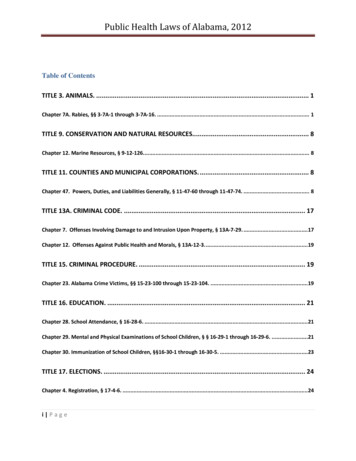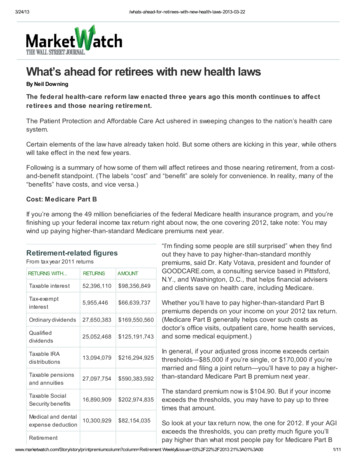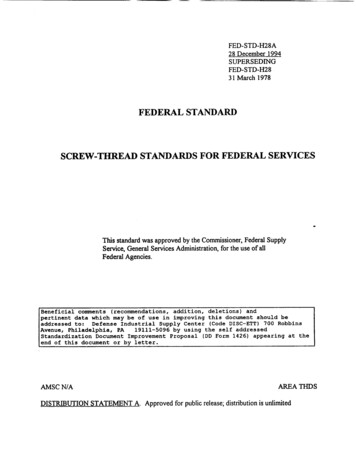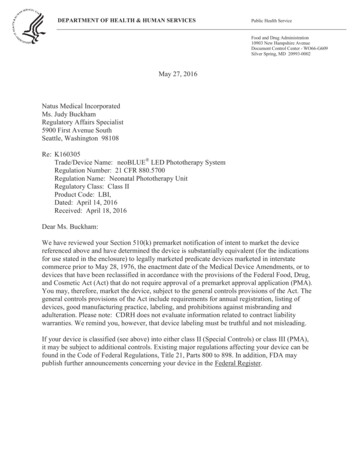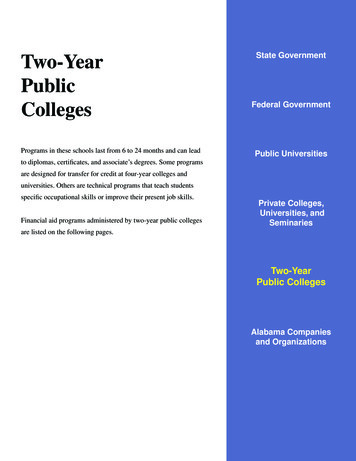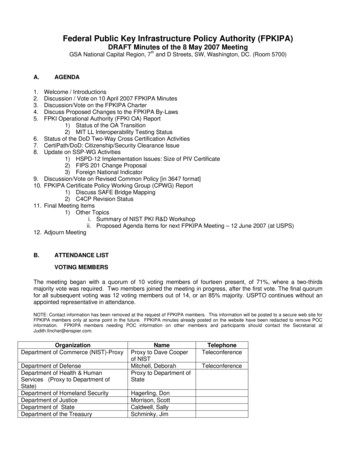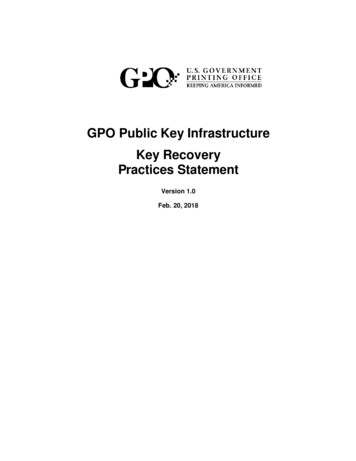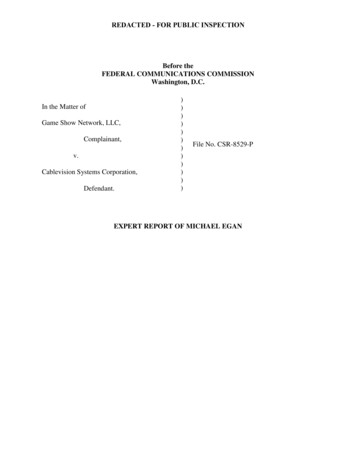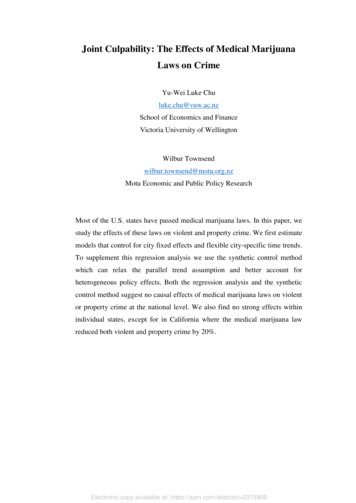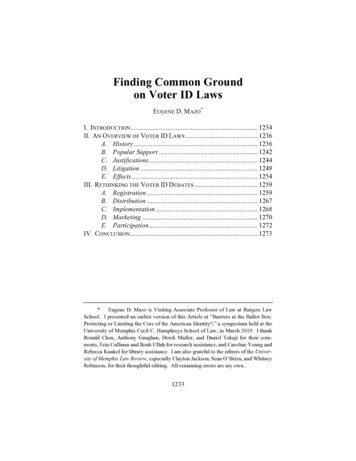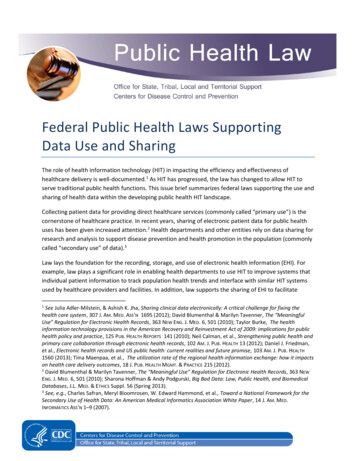
Transcription
Federal Public Health Laws SupportingData Use and SharingThe role of health information technology (HIT) in impacting the efficiency and effectiveness ofhealthcare delivery is well-documented.1 As HIT has progressed, the law has changed to allow HIT toserve traditional public health functions. This issue brief summarizes federal laws supporting the use andsharing of health data within the developing public health HIT landscape.Collecting patient data for providing direct healthcare services (commonly called “primary use”) is thecornerstone of healthcare practice. In recent years, sharing of electronic patient data for public healthuses has been given increased attention.2 Health departments and other entities rely on data sharing forresearch and analysis to support disease prevention and health promotion in the population (commonlycalled “secondary use” of data).3Law lays the foundation for the recording, storage, and use of electronic health information (EHI). Forexample, law plays a significant role in enabling health departments to use HIT to improve systems thatindividual patient information to track population health trends and interface with similar HIT systemsused by healthcare providers and facilities. In addition, law supports the sharing of EHI to facilitate1See Julia Adler-Milstein, & Ashish K. Jha, Sharing clinical data electronically: A critical challenge for fixing thehealth care system, 307 J. AM. MED. ASS’N 1695 (2012); David Blumenthal & Marilyn Tavenner, The “MeaningfulUse” Regulation for Electronic Health Records, 363 NEW ENG. J. MED. 6, 501 (2010); Taylor Burke, The healthinformation technology provisions in the American Recovery and Reinvestment Act of 2009: implications for publichealth policy and practice, 125 PUB. HEALTH REPORTS 141 (2010); Neil Calman, et al., Strengthening public health andprimary care collaboration through electronic health records, 102 AM. J. PUB. HEALTH 13 (2012); Daniel J. Friedman,et al., Electronic health records and US public health: current realities and future promise, 103 AM. J. PUB. HEALTH1560 (2013); Tiina Maenpaa, et al., The utilization rate of the regional health information exchange: how it impactson health care delivery outcomes, 18 J. PUB. HEALTH MGMT. & PRACTICE 215 (2012).2David Blumenthal & Marilyn Tavenner, The “Meaningful Use” Regulation for Electronic Health Records, 363 NEWENG. J. MED. 6, 501 (2010); Sharona Hoffman & Andy Podgurski, Big Bad Data: Law, Public Health, and BiomedicalDatabases, J.L. MED. & ETHICS Suppl. 56 (Spring 2013).3See, e.g., Charles Safran, Meryl Bloomrosen, W. Edward Hammond, et al., Toward a National Framework for theSecondary Use of Health Data: An American Medical Informatics Association White Paper, 14 J. AM. MED.INFORMATICS ASS’N 1–9 (2007).
surveillance, emergency and outbreak response, and health communication, among other essentialpublic health functions.This issue brief summarizes federal laws that have shaped state, tribal, local, and territorial healthdepartments’ use of HIT, including···Laws that promote healthcare providers’ HIT implementation and use;Laws that address how EHI collected for primary uses can be shared with healthcare providersand others for primary and secondary purposes, including public health activities; andPrivacy laws that govern the types of EHI that can be disclosed and the permitted uses of EHI.Promoting Electronic Health Records to Improve Population HealthWhile health information collected for patient care has been used for public health purposes fordecades, the transition from paper to electronic records has revolutionized the efficiency, capacity, andfunctions of the US health system. The electronic revolution in the healthcare sector spreads into thepublic health sector by improving the overall value of information and the ease of sharing it.4 Federallaw has been a driving force in HIT’s implementation and use.5Enacted as part of the American Recovery and Reinvestment Act of 2009, the Health InformationTechnology for Economic and Clinical Health (HITECH) Act launched reforms to promote the use of HITby private providers serving Medicare and Medicaid beneficiaries.6 HITECH Act provisions·····Established the Office of the National Coordinator for Health Information Technology andcommittees that provide standards and specifications for HIT quality;7Required federal agencies to use HIT and provide for its voluntary use by private providers;8Provided for testing, research, grants, and loans for implementation and demonstrations for HITeducation, including financial assistance to states and tribes;9Applied privacy and security requirements and penalties to HIT and required audits andenforcement;10 andSecured incentive payments through the Centers for Medicare and Medicaid Services (CMS) forprofessionals and hospitals that are deemed eligible based on their “meaningful use” of certifiedelectronic health record (EHR) technologies.114Tara Ramanathan, et al., The Role of Law in Supporting Secondary Use of Electronic Health Information,43 J.L. MED. & ETHICS (forthcoming 2015).5Id.642 U.S.C. ch. 156, available atwww.healthit.gov/sites/default/files/hitech act excerpt from arra with index.pdf.742 U.S.C. § 300jj-11.8Id. § 17901.9Id. §§ 17911, 17912, 300jj-31-300jj-38).1042 U.S.C. §§ 17921-17953.11Id. § 300jj-31; 42 C.F.R. §§ 492.6, 492.310; EHR incentive programs, CENTERS FOR MEDICARE AND MEDICAID slation/EHRIncentivePrograms/index.html (last accessed Dec. 4,2
Regulations set three stages of requirements for professionals and facilities to adopt certified EHR12technologies and use them for certain purposes, including public health promotion.13The Stage 1 meaningful use regulations that became effective in 2012 set standards for data capture,use, and sharing that providers must meet for reimbursement.14 The Stage 1 standards support EHRformat uniformity and thus promote better care coordination and outreach to patients.15 CMSguidelines clarify that “meaningful use” includes the goal of improving population health outcomes, thusestablishing link between HIT in the medical community and public health.In addition to the standards relating to patient care, Stage 1 meaningful use regulations includestandards that can promote secondary uses of health data to support public health activities. Forexample, providers can demonstrate meaningful use by generating reports of patients with a specifichealth condition to foster quality improvement, identify and reduce disparities, support research, andfacilitate outreach.16 Providers can demonstrate Stage 1 meaningful use by using EHR systems to submitdata to immunization information systems pursuant to applicable law.17 Stage 1 also allows providers todemonstrate meaningful use by using EHR systems to communicate syndromic surveillance data topublic health departments.18For providers who demonstrate Stage 1 standards,19 the Stage 2 regulations introduce newrequirements for demonstrating meaningful use. As in Stage 1, Stage 2 requirements include standardsthat providers must adopt for incentive payments as well as a menu of standards to give providers someflexibility in demonstrating meaningful use.20 Many Stage 1 requirements are incorporated in the Stage2 regulations to aid progression between meaningful use stages.21 Stage 2 standards include2013) (providing Medicaid payments of 63,750 over six years and Medicare payments of 44,000 over five yearsfor professionals who adopt certified EHRs by 2016, but a 1–3% graduated penalty for only Medicare payments forthose physicians who do not by 2015).12This issue brief uses the term electronic health record or EHR to refer to patient record systems operated byhealthcare providers. In contrast, the term electronic health information or EHI to refers more broadly to digitalhealth information that may or may not be stored in EHR systems.13HealthIT.gov, Meaningful Use Criteria and How to Attain Meaningful Use of ls/how-attain-meaningful-use (last accessed Mar. 4, 2015); HealthIT.gov, ONC, and CMS EHR Incentive Programs and Certification ters/certification-and-ehr-incentives (last accessed Mar. 4, 2015); EHR Incentive Programs supra (layingout specific requirements for professionals under Medicare and Medicaid).1442 C.F.R. § 492.6.15HealthIT.gov, supra.1642 C.F.R. §§ 495.6(e)(3), (g)(4).17Id. §§ 495.6(e)(9), (g)(9).1842 C.F.R. § 495.6(e)(10), (g)(10).19See Medicare and Medicaid Programs; Modifications to the Medicare and Medicaid Electronic Health Record(EHR) Incentive Program for 2014, 79 Fed. Reg. 171, 52910 (Sept. 4 2014) (providing a timetable illustrating theprogression of meaningful use stages).20See 42 C.F.R. § 495.6(j-m).21See CMS.gov, Stage 1 vs. Stage 2 Comparison Table for Eligible Professional lesforEP.pdf (last accessed Dec.29, 2014).3
requirements for clinical care and interoperability for EHRs, including Health Information Exchanges(HIE), electronic prescribing, transmission of records across settings, and increased patient control.22Like Stage 1, Stage 2 includes standards that promote public health activities, including laboratoryreporting, reporting to immunization information systems, reporting to cancer registries and otherspecialized registries, submitting syndromic surveillance data, and identifying patients with specificconditions.23Stage 3, projected to take effect in 2017, seeks to improve quality, safety, efficiency, and healthoutcomes, emphasizing population health improvement.24Encouraging Electronic Data Use and Sharing with StakeholdersIn addition to encouraging provider adoption of EHR’s, HITECH’s incentives encourage sharing healthinformation with stakeholders, such as electronic reporting of laboratory results and syndromicsurveillance data to public health departments, reporting vaccinations to immunization informationsystems, and sending healthcare quality data to CMS.25 However, electronic sharing of EHI depends onthe existence of a functioning technological infrastructure, interoperability of separate HIT systems, and,often, presence of organizations that facilitate information sharing between entities.EHI sharing, broadly the “secure health data exchange between two or more authorized and consentingtrading partners,”26 is not possible without a technical infrastructure for the consenting trading partnersto communicate. HITECH’s incentive payments, which promote the “adoption and meaningful use ofcertified electronic health record (EHR) technology” by healthcare providers, also incentivizeinfrastructure development for EHI sharing by increasing the pervasiveness of HIT systems.27 Moreover,providers may cite sharing EHI as a meaningful use of EHR systems to get HITECH incentive payments.28HITECH also facilitates EHI sharing by giving the Office of the National Coordinator for HealthInformation Technology (ONC) the authority to endorse technical standards.29 Electronic sharing ofhealth information requires that EHR systems are interoperable, or capable of communicating with eachother. Without set standards, EHR vendors might develop systems that are not interoperable. BecauseHITECH authorizes ONC to review and endorse technical standards for EHR systems, ONC can guidedifferent EHR vendors on how to develop interoperable systems.22Health Information Technology: Standards, Implementation Specifications, and Certification Criteria forElectronic Health Record Technology, 77 Fed. Reg. 171, 54163 (Sept. 4, 2012).2342 C.F.R. § 495.6(j-m).2479 Fed. Reg. 171, 52910.2542 C.F.R. § 495.6.26HiMSS, HIE and Meaningful Use Stage 2 Matrix, available s/MU2 HIE Matrix FINAL.pdf (Dec. 2012) (last accessed Dec. 3,2014).2742 C.F.R. § 495.2 (a).28NORC, Evaluation of the State Health Information Exchange Cooperative Agreement s/casestudysynthesisdocument 2-8-13.pdf (last accessed Dec. 4, 2014).2942 U.S.C.A. § 300jj-11 (2014).4
In addition, ONC developed the State HIE Cooperative Agreement Program, which allocates funds toencourage states to facilitate health information sharing. EHI may be shared through a formalizedsystem such as an HIE or a Health Information Organization (HIO), which can vary in structure,organization, function, and scope based on implementation. Health information sharing receives broadsupport from states, private entities such as EHR vendors, and the public. Ultimately, promoting healthinformation sharing allows for consolidation of disparate data and communication of health status andrisks for both primary and secondary uses.Protecting Privacy and Ensuring Data SecurityThe ease with which electronic information can be created and shared highlights the need for theprivacy and security of sensitive EHI. Federal laws set the foundation for sharing data from patients’EHRs. Most discussed in the literature are the privacy and security provisions that control the access,use, and disclosure of individually identifiable health information in the Health Insurance Portability andAccountability Act (HIPAA) Privacy Rule.30The rules implementing HIPAA define protections for health data acquired for primary uses. The generalrule under HIPAA is that patient authorization is required before data are used by or disclosed to otherentities.31 In addition to the protection against use and disclosure, HIPAA allows patients to view theirhealth information and request copies.32 While HIPAA limits the use and disclosure of healthinformation, it also permits certain secondary use exceptions for public health purposes.HIPAA provides certain circumstances under which patient data can be disclosed to health departmentswithout patient authorization. Under HIPAA, providers may disclose identifiable patient data (protectedhealth information or PHI) if required by law, allowing states to pass legal exceptions to HIPAArestrictions.33 Providers may also disclose PHI to health departments without patient authorization forpublic health activities, such as communicable disease reporting, or to a public health authority toprevent or control disease, injury, or disability under the public health exemption.34A covered entity may access, use, and disclose PHI for clinical research without an individual’sauthorization if 1) it obtains documentation of waiver of individual’s authorization by an institutional30Health Insurance Portability and Accountability Act of 1996, Pub. L. No. 104-191, 110 Stat. 1936 (codified asamended in scattered sections of 18 U.S.C., 26 U.S.C., and 42 U.S.C.); 45 C.F.R. Parts 160 and 164 (Subparts A andE) (2013); Deven McGraw & Alice Leiter, A Policy and Technology Framework for Using Clinical Data to ImproveQuality, 12 HOUS. J. HEALTH L. & POL’Y 137, 141 (2012). Other federal laws govern the primary and secondary uses ofspecific types of data (see generally Confidentiality of Alcohol and Drug Abuse Patient Records, 42 C.F.R. pt. 2(2002); Family Educational Rights & Privacy Act, 20 U.S.C. § 1232g (2013); Privacy Act of 1974, 5 U.S.C. § 552a(2010).3145 C.F.R. § 164.508(a)(1).32Id. § 164.502; 45 C.F.R. § 164.524; 45 C.F.R. § 164.528; but see 45 C.F.R. § 164.512.3345 C.F.R. § 164.512(a) (2013).34Id. § 164.512(b) (2013).5
review board or privacy board; 2) the PHI is necessary for this research; or 3) the research is using PHI ofdecedents.35Providers may disclose EHI without patient authorization when the data have been “de-identified,”which usually involves removing 18 types of identification or data aggregation.36 De-identification oftenlimits the data’s utility for surveillance of routine clinical data, but still permits re-identification byproviders or regional health information organizations through randomized patient source codes shoulda public health alert or case report become necessary.37Finally, providers may disclose a “limited data set,” including dates and zip codes, without authorizationand still re-identify patients if they maintain patient codes derived from certain identifiers.38 For otherancillary secondary uses, including institutional “learning” related to quality assessment andimprovement activities, HIPAA permits healthcare entities to access PHI.39 These exemptions andpermitted uses are central to many existing and future secondary uses of EHI.40This issue brief was prepared by Tara Ramanathan, JD, MPH, public health analyst, Cason Schmit, JD,Oak Ridge Institute for Science and Education (ORISE) fellow, Akshara Menon, JD, MPH, ORISE fellow,Dawn Pepin, JD, MPH, ORISE fellow, and Gregory Sunshine, JD, ORISE fellow with the assistance ofMatthew Penn, Director, JD, MLIS, with the Public Health Law Program (PHLP) within the Centers forDisease Control and Prevention’s (CDC’s) Office for State, Tribal, Local and Territorial Support.PHLP provides technical assistance and public health law resources to advance the use of law as a publichealth tool. PHLP cannot provide legal advice on any issue and cannot represent any individual or entityin any matter. PHLP recommends seeking the advice of an attorney or other qualified professional withquestions regarding the application of law to a specific circumstance. The findings and conclusions in thissummary are those of the authors and do not necessarily represent the official views of CDC.This issue brief includes laws enacted through December 2014. Published March 19, 2015.35Id. § 164.512(i) (2013). HIPAA rules separately define clinical research as any investigation or evaluation createdto develop or enhance generalizable knowledge. 45 C.F.R. § 164.501 (2013). The Common Rule further governs theuse of PHI by participating departments and agencies researching human subjects (see Federal Policy for theProtection of Human Subjects, 45 C.F.R. pt. 46 (2005))36Data can also be deemed to be de-identified if an expert determines that there is a “very small” risk that datacould be re-identified. 45 C.F.R. § 164.514(b) (2013).37Standards for Privacy of Individually Identifiable Health Information, 67 Fed. Reg. 157 (Aug. 14, 2001); 45 C.F.R.§ 164.514(b).3845 C.F.R. § 164.514(e) (2013); see also Soumitra Sengupta, Neil S. Calman, George Hripcsak, A Model forExpanded Public Health Reporting in the Context of HIPAA, 15 J. AM. MED. INFORMATICS ASS’N 5, 569–70 (2008).3945 C.F.R. § 164.501 (2013) (defining health-care uses of PHI); U.S. DEPARTMENT OF HEALTH & HUMAN SERVICES, OCRPrivacy Brief: Summary of the HIPAA Privacy Rule 4–10 (2003), available ng/summary/privacysummary.pdf (last accessed Mar. 4,2015).40Centers for Disease Control and Prevention, HIPAA Privacy Rule and Public Health: Guidance from CDC and theUS Department of Health and Human Services, 52 MMWR 1 (Apr. 11, 2003), available 1.htm (last accessed Mar. 4, 2015).6
HITECH authorizes ONC to review and endorse technical standards for EHR systems, ONC can guide different EHR vendors on how to develop interoperable systems. 22 Health Information Technology: Standards, Implementation Specifications, and Certification Criteria for Electronic Health Record Technology, 77 Fed. Reg. 171, 54163 (Sept. 4, 2012).
